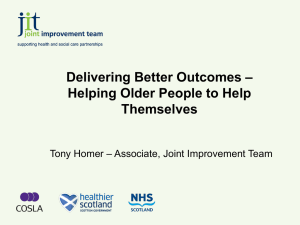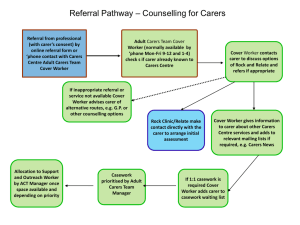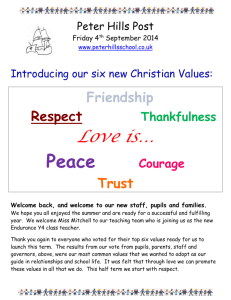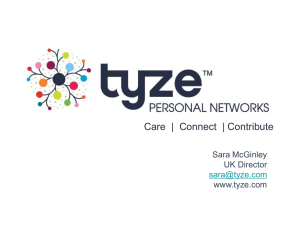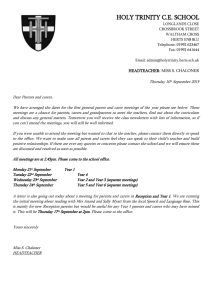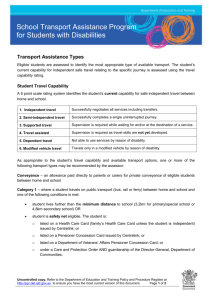Threshold Levels 1-4 at a glance
advertisement
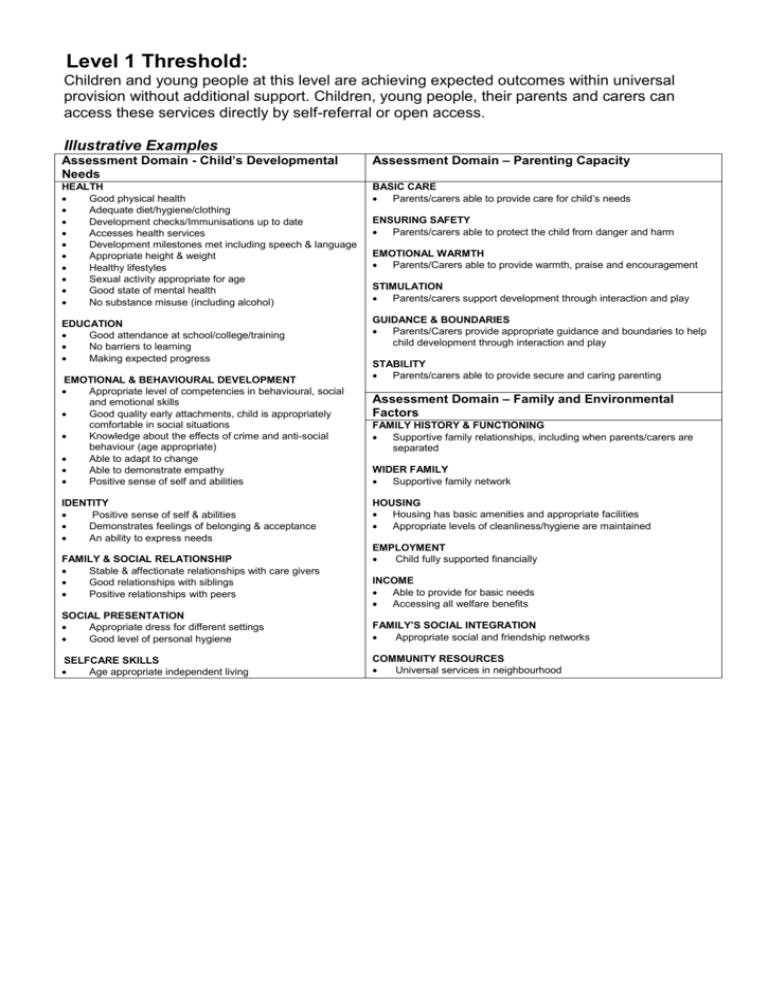
Level 1 Threshold: Children and young people at this level are achieving expected outcomes within universal provision without additional support. Children, young people, their parents and carers can access these services directly by self-referral or open access. Illustrative Examples Assessment Domain - Child’s Developmental Needs Assessment Domain – Parenting Capacity HEALTH Good physical health Adequate diet/hygiene/clothing Development checks/Immunisations up to date Accesses health services Development milestones met including speech & language Appropriate height & weight Healthy lifestyles Sexual activity appropriate for age Good state of mental health No substance misuse (including alcohol) BASIC CARE Parents/carers able to provide care for child’s needs EDUCATION Good attendance at school/college/training No barriers to learning Making expected progress GUIDANCE & BOUNDARIES Parents/Carers provide appropriate guidance and boundaries to help child development through interaction and play EMOTIONAL & BEHAVIOURAL DEVELOPMENT Appropriate level of competencies in behavioural, social and emotional skills Good quality early attachments, child is appropriately comfortable in social situations Knowledge about the effects of crime and anti-social behaviour (age appropriate) Able to adapt to change Able to demonstrate empathy Positive sense of self and abilities IDENTITY Positive sense of self & abilities Demonstrates feelings of belonging & acceptance An ability to express needs FAMILY & SOCIAL RELATIONSHIP Stable & affectionate relationships with care givers Good relationships with siblings Positive relationships with peers ENSURING SAFETY Parents/carers able to protect the child from danger and harm EMOTIONAL WARMTH Parents/Carers able to provide warmth, praise and encouragement STIMULATION Parents/carers support development through interaction and play STABILITY Parents/carers able to provide secure and caring parenting Assessment Domain – Family and Environmental Factors FAMILY HISTORY & FUNCTIONING Supportive family relationships, including when parents/carers are separated WIDER FAMILY Supportive family network HOUSING Housing has basic amenities and appropriate facilities Appropriate levels of cleanliness/hygiene are maintained EMPLOYMENT Child fully supported financially INCOME Able to provide for basic needs Accessing all welfare benefits SOCIAL PRESENTATION Appropriate dress for different settings Good level of personal hygiene FAMILY’S SOCIAL INTEGRATION Appropriate social and friendship networks SELFCARE SKILLS Age appropriate independent living COMMUNITY RESOURCES Universal services in neighbourhood Level 2 and Level 3a Threshold: Those children and young people who require an additional service from a single practitioner or agency, or who are best supported under the Common Assessment Framework (CAF) with an appointed Lead Practitioner to co-ordinate a multi-agency response to their needs. Illustrative Examples Assessment Domain - Child’s Developmental Needs Assessment Domain – Parenting Capacity HEALTH Slow in reaching development milestones Missing immunisations or checks Susceptible to minor health problems Minor concerns ref: diet, hygiene, clothing, alcohol consumption (but not immediately dangerous) Disability requiring support services Starting to have sex (under 16) Previous pregnancy Low level mental health or emotional issues requiring tier 2 Child and Adolescent Mental Health Services BASIC CARE Parents/carers engagement with services is poor Professionals are beginning to have some concerns over the child’s physical needs not being met Parents/carers mental health issues may have an impact on the health or development of the child unless appropriate support provided EDUCATION Occasional truanting or non-attendance, poor punctuality At risk of fixed term exclusion or previous fixed term exclusion Identified language and communication difficulties linked to other un-met needs Additional learning needs Lack of age appropriate stimulation or opportunities to learn Not in education, employment or training (NEET) Not making expected educational progress Not educated at school or at home by parents/carers Missing from education due to being missing from home EMOTIONAL & BEHAVIOURAL DEVELOPMENT Low level mental health or emotional issues requiring intervention Substance misuse that is not immediately dangerous including alcohol Involved in anti-social behaviour Attachment issues and or emotional development delay Low self esteem Child bullies others Limited peer relationships/social isolation Emerging anti-social behaviour and attitudes and/or low level offending Received Triage, out of court disposal or police restorative justice intervention’ Some evidence of risky use of technology leading to E-safety concerns Associates with peers involved in gangs Shows some indicators of being potentially vulnerable to CSE ENSURING SAFETY Parent/carer requires advice on parenting issues Some exposure to dangerous situations in home/community eg missing from home Professionals are beginning to have some concerns around substance misuse (including alcohol) by adults within the home EMOTIONAL WARMTH Lack of response to concerns raised about a child’s welfare Perceived to be a problem by parent/carer STIMULATION Child not exposed to new experiences Child spends much time alone GUIDANCE & BOUNDARIES Parents/Carers provide inconsistent boundaries Parent/carer has age inappropriate expectations that child should be self-reliant Lack of response to concerns raised about the child STABILITY Inconsistent parenting/caring, but development not significantly impaired Assessment Domain – Family and Environmental Factors FAMILY HISTORY & FUNCTIONING Parents have relationship difficulties that may affect the child Experience loss of significant adult Looks after younger siblings Parent/carer has health difficulties WIDER FAMILY Some support from family and friends IDENTITY Some insecurities around identity May experience bullying around ‘being different’ Expressing wish to become pregnant at a young age HOUSING Overcrowding (as per local guidelines) that has potential impact on child’s health or development Housing in poor state of repair FAMILY & SOCIAL RELATIONSHIP Some support from family and friends Has some difficulties sustaining relationships Undertaking occasional caring responsibilities Child of a teenage parent Child adopted from care Low parental aspirations Starts to go missing from home EMPLOYMENT Parents/carers unable to access appropriate services to meet the child’s additional needs due to long hours or un-social hours Family affected by unemployment SOCIAL PRESENTATION Can be over friendly or withdrawn with strangers Personal hygiene starting to be a problem SELFCARE SKILLS Not always adequate self-care – poor hygiene Slow to develop age appropriate self-care skills Overprotected/unable to develop independence INCOME Parents/carers have low income plus adverse additional factors that affect the child’s development Not accessing all welfare benefits FAMILY’S SOCIAL INTEGRATION Family new to area Some social exclusions problems Victimisation by others COMMUNITY RESOURCES Adequate universal resources but family may have access issues Level 3b Threshold: Children and young people who are potentially Children in Need (Section 17, Children Act 1989). These children and young people require referral to Children’s Social Care for assessment. You should complete and attach any assessment tool you may have used for e.g. Graded Care Profile Illustrative Examples Assessment Domain - Child’s Developmental Needs Assessment Domain – Parenting Capacity HEALTH Some concerns around mental health Has some chronic/recurring health problems Missed routine and non-routine health appointments Significant dental decay Poor or restrictive diets despite interventions Serious delay in achieving physical and other developmental milestones, raising significant concerns Frequent accidental injuries to child requiring hospital treatment Concerns regarding diet, hygiene and clothing Conception to child under 16 Sex with multiple partners Administration of substances in a dangerous manner (sharing equipment etc) Substance misuse impacts negatively on their risk taking behaviour (e.g. unprotected sex) Mental health issues requiring referral to child adolescent mental health services, including self-harm or suicidal thoughts Disability requiring significant support services BASIC CARE Parent/carer is struggling to provide adequate care even with support Parental/carer learning disability, substance misuse (including alcohol) or mental health impacting on the parent’s/carer’s ability to meet the needs of the child Chronic or acute neglect where food, warmth and other basics often not available Missing from home or care and concerns raised about their physical and emotional safety and welfare EDUCATION Short term exclusion or persistent truanting, poor school attendance At risk of permanent exclusion or previous permanent exclusion Identified learning needs including statement of special educational needs Not making expected educational progress Limited access to books, toys Persistent not in education, employment or training (NEET) EMOTIONAL & BEHAVIOURAL DEVELOPMENT Difficulty coping with anger, frustration and upset Physical and emotional development raising significant concerns Significant attachment difficulties e.g. child adopted from care Attachment issues and or emotional development delay Early onset of sexual activity (13-14) Dangerous substance misuse (including alcohol) (Re-) Offending or regular anti-social behaviour Missing from home or care and concerns raised about their physical and emotional safety and welfare Child/young person out of control in the community At risk of sexual exploitation Is suspected of starting affiliations and/or periphery of gangs membership Suspected/convicted of carrying weapons Regular risk taking behaviour putting their safety at risk and impacting upon their welfare. IDENTITY Subject to discrimination Significant low self esteem Extremist views Continuous breaches of curfew/order with other risk taking behaviours that impact on the child’s welfare and safety FAMILY & SOCIAL RELATIONSHIP Peers also involved in challenging behaviour Regularly needed to care for another family member Involved in conflicts with peers/siblings Adoptive family under severe stress ENSURING SAFETY Child exposed to contact with individuals who pose a risk of physical or sexual harm to children Previously subject to child protection plan Teenage parent(s) Either or both previously looked after EMOTIONAL WARMTH Child often the scapegoated Child is rarely comforted when distressed Parent is emotionally unavailable Parental instability affects capacity to nurture STIMULATION Child or young person receives little positive stimulation despite appropriate toys being available GUIDANCE & BOUNDARIES Parent rarely referees disputes between siblings Parents/carers provide inconsistent boundaries or present a negative role model which seriously impacts on the child’s development STABILITY Receives inconsistent care Has no other positive relationships Succession of carers or child/young person has multiple carers, but no significant relationships with any of them Inappropriate child care arrangements Assessment Domain – Family and Environmental Factors FAMILY HISTORY & FUNCTIONING Domestic abuse where the risk to the victim is assessed as standard/medium risk and the child is present within the home during the incident An initial domestic abuse incident is reported but the victim discloses details of historic abuse with children resident/normally resident Acrimonious divorce/separation Parental/sibling involvement in crime Evidence of problematic substance misuse Unaccompanied asylum seeking children Child is privately fostered Child subject to a court application where a section 7 or section 37 report has been ordered to be completed by children’s social care Pre-birth assessment were a history of past child protection concerns Child is a young carer requiring assessment of additional needs Child requires assessment for respite care services due to family circumstances and has no appropriate friend/relative carer available for support Parents/carers unwilling to continue to care for the child WIDER FAMILY Family members have physical and mental health difficulties On the fringes of involvement in gang culture SOCIAL PRESENTATION Clothing regularly unwashed Hygiene problems Is provocative in behaviour/appearance – at risk of sexual exploitation SELFCARE SKILLS Child suffers accidental injury as a result of inadequate supervision Severe lack of age appropriate behaviour Child found wandering without adequate supervision Child expected to be self-reliant for their own basic needs or those of their siblings beyond their capabilities, placing them at potential risk Risk of family relationship breakdown leading to need for child to become looked after outside of family network Family suspected of being involved in gang activity or crime HOUSING Homeless child in need of accommodation including 16-17 year olds Family at risk of eviction Temporary accommodation EMPLOYMENT History of long periods of unemployment INCOME No access to funding Serious debts/poverty impacting on ability to care for the child FAMILY’S SOCIAL INTEGRATION Family socially excluded Escalating victimisation COMMUNITY RESOURCES Parents/carers socially excluded with access problems to local facilities and targeted services In determining whether a referral is necessary to Children’s Social Care, full consideration should be given as to why the support needs cannot be met without social worker intervention: Why a social worker? What outcome do you expect to achieve? Discuss with your agency Child Protection lead prior to making a referral. Threshold Level 4: There are a smaller group of children and young people who require intensive help and support to meet their needs. Children and young people will access specialist services following a statutory assessment. Children and young people who have acute needs and must be referred to Children’s Social Care services. Illustrative Examples Assessment Domain - Child’s Developmental Needs Assessment Domain – Parenting Capacity HEALTH Has complex/chronic health problems Persistent substance misuse Non-organic failure to thrive Fabricated illness Early teenage pregnancy Serious mental health issues Seriously obese Dental decay and no access to treatment Sexual exploitation/abuse Sexual activity under the age of 13 Disability requiring highest level of support services BASIC CARE Parent/carer unable to provide ‘good enough’ parenting that is adequate and safe Parents/carers mental health problems, including self-harming behaviour, that present a risk of significant harm to the child Parent/carer learning difficulties that present a risk of significant harm to the child or young person Parent/carer’s substance misuse that present a risk of significant harm to the child or young person Parental/carer health/disability that presents a risk of significant harm to the child or young person Parents/carers unable to care for previous children Low warmth, high criticism is an enduring feature of the parenting style EDUCATION Not attending education provision Permanently excluded from school History of previous exclusions Significant development delay due to neglect/poor parenting EMOTIONAL & BEHAVIOURAL DEVELOPMENT Regularly involved in anti-social/criminal activities Puts self or others in danger Endangers own life through self-harm/substance misuse including alcohol/eating disorder/suicidal attempts In sexually exploitative relationship Frequently goes missing from home or care for long periods Child who abuses others Severe attachment problems and/or sever emotional development delay Involved in gun and gang crime Known to carry weapon(s) IDENTITY Experiences persistent discrimination Is social isolated and lacks appropriate role models Alienate self from others Distorted self-image FAMILY & SOCIAL RELATIONSHIP Looked after child Care leaver Family breakdown related in some way to child’s behavioural difficulties Subject to physical, emotional or sexual abuse/neglect Female genital mutilation Is main carer for a family member Adoption breakdown Forced marriage of a minor Honour based violence SOCIAL PRESENTATION Poor and inappropriate self-presentation SELFCARE SKILLS Neglects to use self-care skills due to alternative priorities e.g. substance misuse Unaccompanied asylum seeker ENSURING SAFETY There is instability and violence in the home continually Parents are involved in crime Parents unable to keep child safe Victim of crime Parents/carers have or may have abused/neglected the child/young person Parent/carer unable to restrict access to the home by adults known to be a risk to children or young people and/or other adults Pre-birth assessment indicates unborn child is at risk of significant harm Child/young person left in the care of an adult or young person known or suspected to be a risk to children, or lives in the same house as the child Frequently goes missing from home or care Child trafficking EMOTIONAL WARMTH Parent’s inconsistent, highly critical or apathetic of child Deliberate cruelty or emotional ill treatment of a child or young person resulting in significant harm STIMULATION Child or young person receives no positive stimulation GUIDANCE & BOUNDARIES No effective boundaries set by parents Regularly behaves in an anti-social way in neighbourhood Child beyond parental/carer control Subject to a parenting order which may be related to their child/young person’s criminal behaviour, anti-social behaviour or persistent absence from school STABILITY Child is rejected or abandoned Previous child/young person have been removed from parent’s/carer’s care Assessment Domain – Family and Environmental Factors FAMILY HISTORY & FUNCTIONING Significant parent discord and persistent domestic violence Child’s carer or parent referred to MARAC Child looked after by a non-relative within scope of private fostering arrangement Parents are deceased and there are no family/friends options Assessment identifies risk of physical, emotional, sexual abuse or neglect History of previous significant harm to children, including any concerns of previous child deaths WIDER FAMILY Destructive relationship with wider family Assessment identifies risk of physical, emotional, sexual abuse or neglect Members of the wider family are known to be, or suspected of being, a risk to children Family involved in gang activity or crime HOUSING Physical accommodation places child in immediate danger No fixed abode or homeless Temporary accommodation EMPLOYMENT Chronic unemployment due to significant lack of basic skills or long standing issues such as substance misuse (includes alcohol)/offending etc INCOME Extreme poverty/debt impacting on ability to care for child FAMILY’S SOCIAL INTEGRATION Family chronically socially excluded COMMUNITY RESOURCES Poor quality services with long-term difficulties with accessing target populations Restricting and refusing interventions from services

